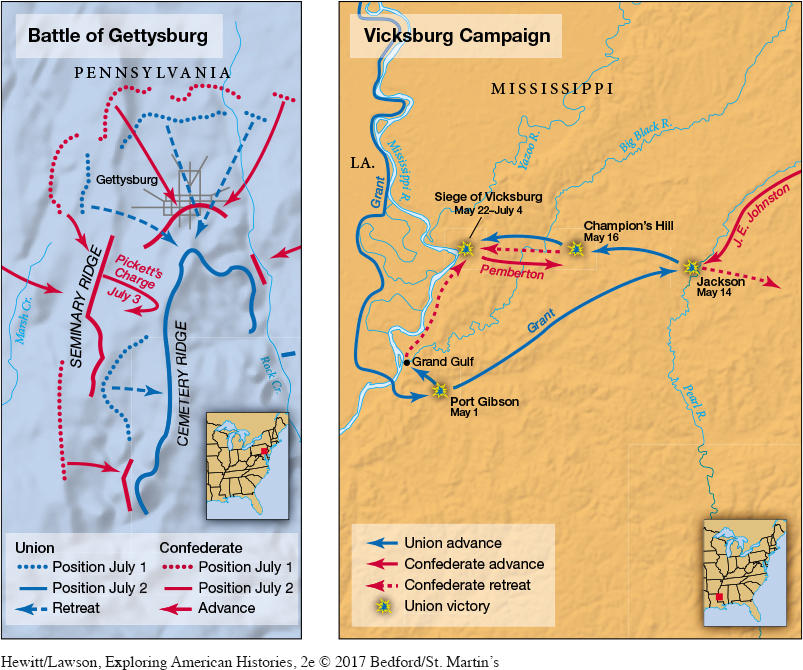Key Victories for the Union
In mid-1863 Confederate commanders believed the tide was turning in their favor. Following victories at Fredericksburg and Chancellorsville, General Lee launched an invasion of northern territory. While the Union army maneuvered to protect Washington, D.C., General Joseph Hooker resigned as its head. When Lincoln appointed George A. Meade as the new Union commander, the general immediately faced a major engagement at the Battle of Gettysburg in Pennsylvania. If Confederates won a victory there, European countries might finally recognize the southern nation and force the North to accept peace.
Neither Lee nor Meade set out to launch a battle in this small Pennsylvania town. But Lee was afraid of outrunning his supply lines, and Meade wanted to keep Confederates from gaining control of the roads that crossed at Gettysburg. So between July 1 and July 3, the opposing armies fought a desperate battle with Union troops occupying the high ground and Confederate forces launching deadly assaults from below (Map 13.2). Ultimately, Gettysburg proved a disaster for the South: More than 4,700 Confederates were killed, including a large number of officers; another 18,000 were wounded, captured, or missing. Although the Union suffered similar casualties, it had more men to lose, and it could claim victory.

As Lee retreated to Virginia, the South suffered another devastating defeat. Troops under General Grant had been pounding Vicksburg, Mississippi, since May 1863. The siege of Vicksburg ended with the surrender of Confederate forces on July 4. This victory was even more important strategically than Gettysburg (Map 13.2). Combined with a victory five days later at Port Hudson, Louisiana, the Union army controlled the entire Mississippi valley, the richest plantation region in the South. This series of victories also effectively cut Louisiana, Arkansas, and Texas off from the rest of the Confederacy, ensuring Union control of the West. In November 1863 Grant’s troops achieved another major victory at Chattanooga, opening up much of the South’s remaining territory to invasion. Thousands of slaves deserted their plantations, and many joined the Union war effort.
As 1864 dawned, the Union had twice as many forces in the field as the Confederacy, whose soldiers were suffering from low morale, high mortality, and dwindling supplies. Although some difficult battles lay ahead, the war of attrition (in which the larger, better-supplied Union forces slowly wore down their Confederate opponents) had begun to pay dividends.
The changing Union fortunes increased support for Lincoln and his congressional allies. Union victories and the Emancipation Proclamation also convinced Great Britain not to recognize the Confederacy as an independent nation. And the heroics of African American soldiers, who engaged in direct and often brutal combat against southern troops, expanded support for emancipation. Republicans, who now fully embraced abolition as a war aim, were nearly assured the presidency and a congressional majority in the 1864 elections.
Northern Democrats still campaigned for peace and the readmission of Confederate states with slavery intact. They nominated George B. McClellan, the onetime Union commander, for president. McClellan attracted working-class and immigrant voters who traditionally supported the Democrats and bore the heaviest burdens of the war. But Democratic hopes for victory in November were crushed when Union general William Tecumseh Sherman captured Atlanta, Georgia, just two months before the election. Lincoln and the Republicans won easily, giving the party a clear mandate to continue the war to its conclusion.
Exploring American HistoriesPrinted Page 433
Exploring American Histories Value EditionPrinted Page 321
Chapter Timeline